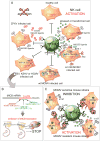Modulation of natural killer cell activity by viruses
- PMID: 20558100
- PMCID: PMC2920364
- DOI: 10.1016/j.mib.2010.05.011
Modulation of natural killer cell activity by viruses
Abstract
Since their discovery, our understanding of NK cells has evolved from branding them marginal innate immunity cells to key players in anti-viral and anti-tumor immunity. Importance of NK cells in control of various viral infections is perhaps best illustrated by the existence of plethora of viral mechanisms aimed to modulate their function. These mechanisms include not only virally encoded immunoevasion proteins but also viral miRNA. Moreover, the evidence has been accumulated supporting the role of viral immunoevasion of NK cells in viral pathogenesis in vivo.
Copyright 2010 Elsevier Ltd. All rights reserved.
Conflict of interest statement
The authors do not claim any conflict of interest.
Figures


Comment in
-
The interaction of viruses with host immune defenses.Curr Opin Microbiol. 2010 Aug;13(4):501-2. doi: 10.1016/j.mib.2010.07.001. Epub 2010 Jul 23. Curr Opin Microbiol. 2010. PMID: 20650675 No abstract available.
References
-
- Cooper MA, Elliott JM, Keyel PA, Yang L, Carrero JA, Yokoyama WM. Cytokine-induced memory-like natural killer cells. Proc Natl Acad Sci U S A. 2009;106:1915–1919. Using in vivo adoptive transfer of NK cells with history of prior activation by cytokines the authors show NK cell ability to retain memory of prior activation. - PMC - PubMed
-
- Sun JC, Beilke JN, Lanier LL. Adaptive immune features of natural killer cells. Nature. 2009;457:557–561. Using the model of murine cytomegalovirus infection in Ly49H+ animals the authors have shown that NK cells expressing virus specific receptor, acquire characteristic of memory cells. Adoptive transfer of these NK cells into naive animals followed by challenge infection respond stronger and offer better protection as compared to naïve NK cells. - PMC - PubMed
-
- O’Leary JG, Goodarzi M, Drayton DL, von Andrian UH. T cell- and B cell-independent adaptive immunity mediated by natural killer cells. Nat Immunol. 2006;7:507–516. - PubMed
-
- Mao H, Tu W, Qin G, Law HK, Sia SF, Chan PL, Liu Y, Lam KT, Zheng J, Peiris M, et al. Influenza virus directly infects human natural killer cells and induces cell apoptosis. J Virol. 2009;83:9215–9222. Authors show that influenza virus can directly target, replicate in and kill NK cells, thus showing a potential novel strategy of influenza virus to evade the NK cell innate immune. - PMC - PubMed
-
- Guo H, Kumar P, Moran TM, Garcia-Sastre A, Zhou Y, Malarkannan S. The functional impairment of natural killer cells during influenza virus infection. Immunol Cell Biol. 2009;87:579–589. Using the mouse-adopted influenza virus strain the authors show infection of spleen-derived NK cells. However, unlike the results of Mao et al., the infection of mouse NK cells was not productive. Although there were no alterations in expression levels of activating and inhibitory receptors, the infection caused the reduction in natural cytotoxicity. - PMC - PubMed
Publication types
MeSH terms
Substances
Grants and funding
LinkOut - more resources
Full Text Sources
Other Literature Sources
Medical

